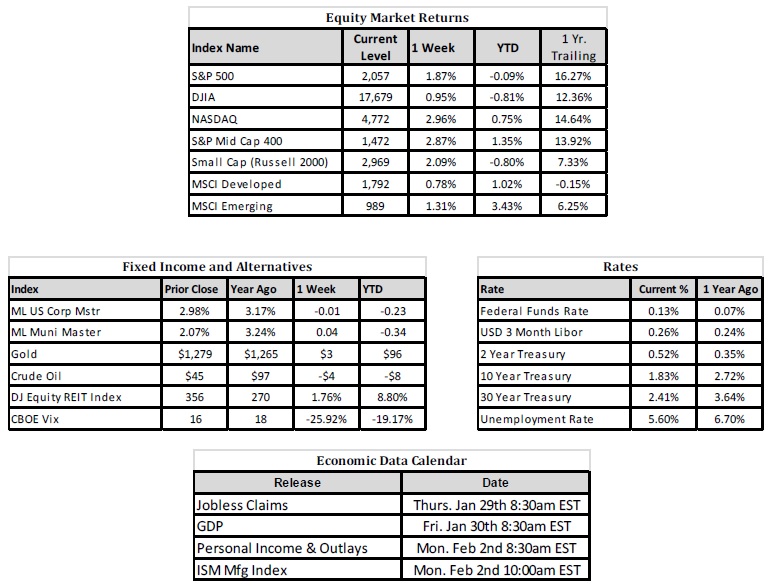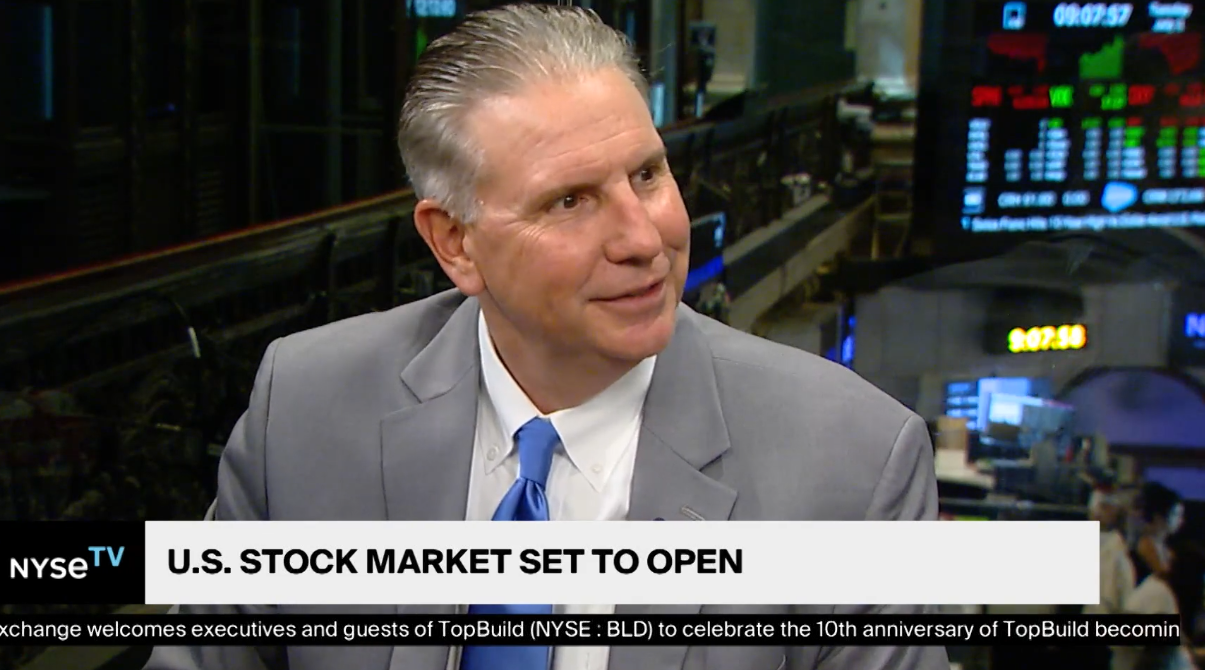
Capital Markets Update – Week of 1/26/2015
Market Overview
Sources: Rates Data and Economic Calendar—Bloomberg Markets as of 1/28/15; Equity Market Returns and Fixed Income and Alternatives Data—Wells Fargo Advisers as of 1/26/15.
Happening Now
U.S. Markets Continue to Offer Opportunities for Diversified Investors
U.S. Markets continue to try and find stable ground to stand on in 2015 but are down over 1% as of the time of this writing. In terms of individual sector performance, defensive sectors such as Utilities (+4.15%) and Healthcare (+4.62%) have posted strong returns as investors look to take advantage of the relative strength of the U.S. economy through historically less volatile areas of the market. REITs (+8.19%) continue to prove attractive as rates on most fixed income securities remain low and a more cautious approach is taken with regards to investments in energy related, high yielding MLP securities that have been a source of income for yield starved investors in this low interest rate environment.
Of the 18 trading days since the start of 2015, the S&P 500 index has posted negative returns over 60% of the time and has seen a positive daily gain only 7 times. Interestingly, however, is that on the 5 days when the market has moved by more than 1%, it posted gains 80% of the time! This is a result of the market finding more conviction to the upside when uncertainties are addressed. For example, perhaps the biggest uncertainty entering 2015 was the steep fall in the price of oil and where it was headed. When oil stabilized around $50 a barrel on January 7 and January 8, the market posted its largest two day advance of the year gaining a cumulative 2.98%. Further, on January 16, a day after the market absorbed the surprising news of the Swiss removing their currency peg to the Euro, the S&P 500 index advanced 1.34%. Yet another uncertainty this month has been what action the European Central Bank would take with regards to their asset purchase program. Last Thursday, January 22, when Mario Draghi announced the ECB will be purchasing €60 billion of sovereign debt a month until the end of September 2016, the U.S. market increased 1.53%.
Important Information and Disclaimers
Past Performance is not a guarantee of future performance.
Investing in foreign securities presents certain risks not associated with domestic investments, such as currency fluctuation, political and economic instability, and different accounting standards. This may result in greater share price volatility. These risks are heightened in emerging markets.
There are special risks associated with an investment in real estate, including credit risk, interest rate fluctuations and the impact of varied economic conditions. Distributions from REIT investments are taxed at the owner’s tax bracket.
The prices of small company and mid cap stocks are generally more volatile than large company stocks. They often involve higher risks because smaller companies may lack the management expertise, financial resources, product diversification and competitive strengths to endure adverse economic conditions.
Investing in commodities is not suitable for all investors. Exposure to the commodities markets may subject an investment to greater share price volatility than an investment in traditional equity or debt securities. Investments in commodities may be affected by changes in overall market movements, commodity index volatility, changes in interest rates or factors affecting a particular industry or commodity.
Products that invest in commodities may employ more complex strategies which may expose investors to additional risks.
Investing in fixed income securities involves certain risks such as market risk if sold prior to maturity and credit risk especially if investing in high yield bonds, which have lower ratings and are subject to greater volatility. All fixed income investments may be worth less than original cost upon redemption or maturity. Bond Prices fluctuate inversely to changes in interest rates. Therefore, a general rise in interest rates can result in the decline of the value of your investment.
Definitions
MSCI- EAFE: The Morgan Stanley Capital International Europe, Australasia and Far East Index, a free float-adjusted market capitalization index that is designed to measure developed-market equity performance, excluding the United States and Canada.
MSCI-Emerging Markets: The Morgan Stanley Capital International Emerging Market Index, is a free float-adjusted market capitalization index that is designed to measure the performance of global emerging markets of about 25 emerging economies.
Russell 3000: The Russell 3000 measures the performance of the 3000 largest US companies based on total market capitalization and represents about 98% of the investible US Equity market.
ML BOFA US Corp Mstr [Merill Lynch US Corporate Master]: The Merrill Lynch Corporate Master Market Index is a statistical composite tracking the performance of the entire US corporate bond market over time.
ML Muni Master [Merill Lynch US Corporate Master]: The Merrill Lynch Municipal Bond Master Index is a broad measure of the municipal fixed income market.
Investors cannot directly purchase any index.
LIBOR, London Interbank Offered Rate, is the rate of interest at which banks offer to lend money to one another in the wholesale money markets in London.
The Dow Jones Industrial Average is an unweighted index of 30 “blue-chip” industrial U.S. stocks.
The S&P Midcap 400 Index is a capitalization-weighted index measuring the performance of the mid-range sector of the U.S. stock market, and represents approximately 7% of the total market value of U.S. equities. Companies in the Index fall between S&P 500 Index and the S&P SmallCap 600 Index in size: between $1-4 billion.
DJ Equity REIT Index represents all publicly traded real estate investment trusts in the Dow Jones U.S. stock universe classified as Equity REITs according to the S&P Dow Jones Indices REIT Industry Classification Hierarchy. These companies are REITSs that primarily own and operate income-producing real estate.




